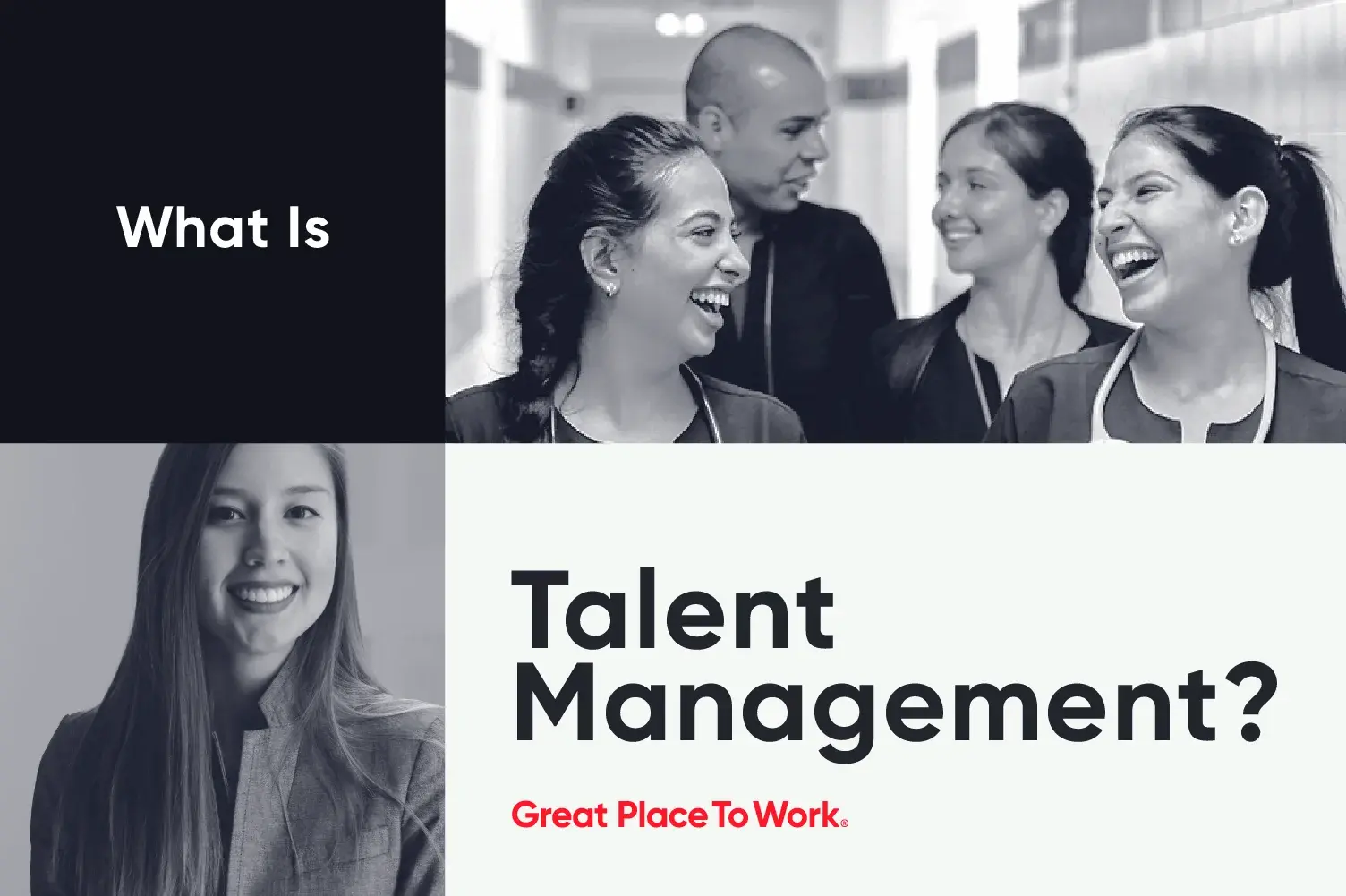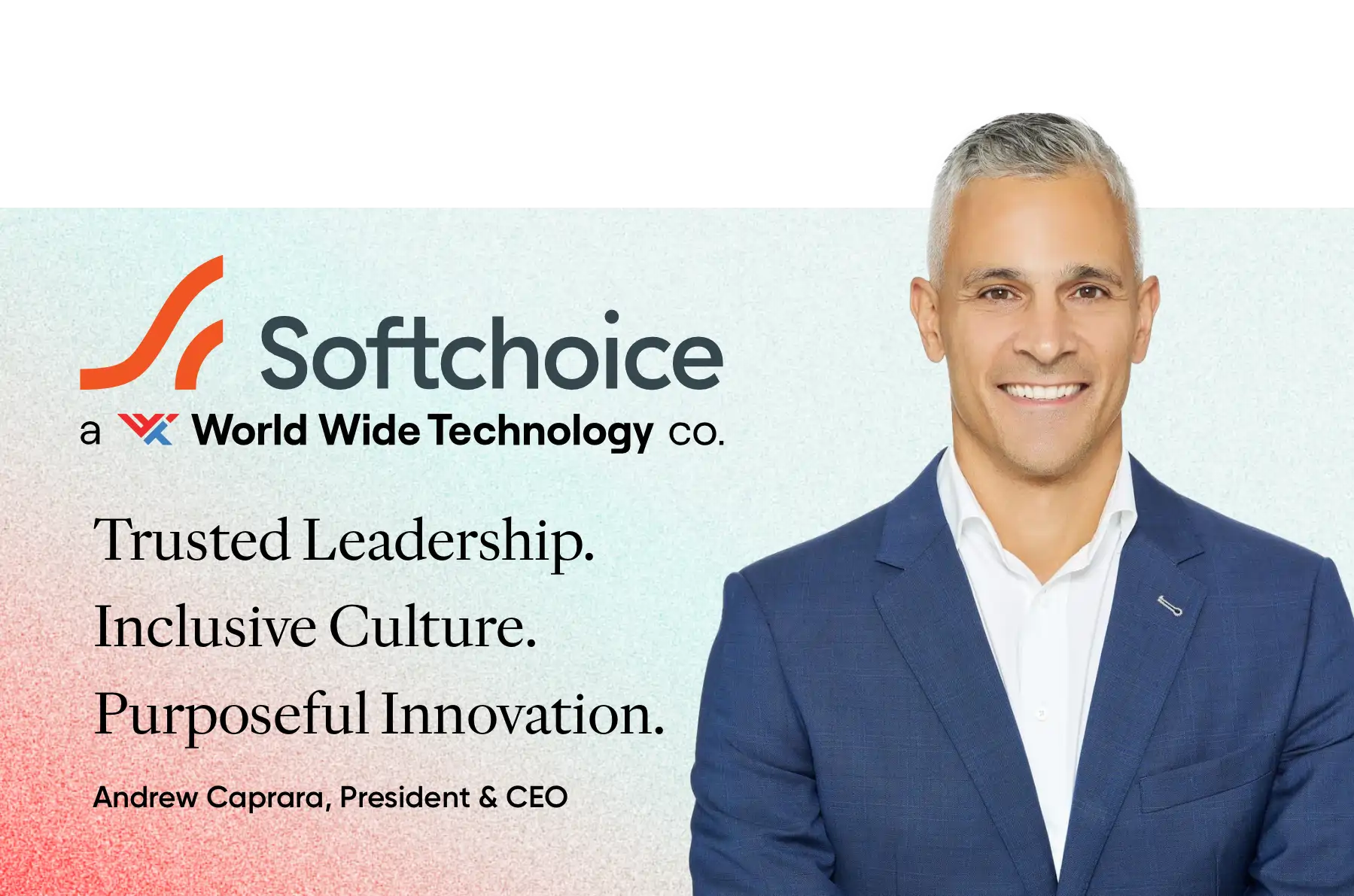Leadership, Talent Acquisition
Talent management refers to a strategic and structured approach focused on attracting, developing, and retaining high-performing employees. An effective talent management strategy ensures that employee growth and engagement are aligned with broader organizational outcomes.
A talent management strategy is essential for every organization. For companies that felt the impact of recent workforce shifts—or understand the connection between workplace culture and business performance—the importance is clear. As employees increasingly recognized dissatisfaction within their workplaces, many chose to leave, prompting employers to quickly re-evaluate their practices.
According to a recent analysis by Great Place to Work®, this shift represented a significant moment in the competition for talent. Employees began redefining their expectations from employers—seeking greater fairness, flexibility, and support for their overall well-being. In response, the standards for talent management evolved accordingly.
What is talent management?
Talent management is the ongoing process of supporting employees throughout every phase of their journey with an organization—not just during recruitment, but through development, retention, and eventual departure. An effective talent strategy addresses the full employee experience and typically includes:
- Recruitment
- Compensation (including pay, benefits, and perks)
- Onboarding
- Fostering connection and community
- Employee engagement
- Training and development
- Organizational culture
- A sense of purpose
- Succession planning and exit practices
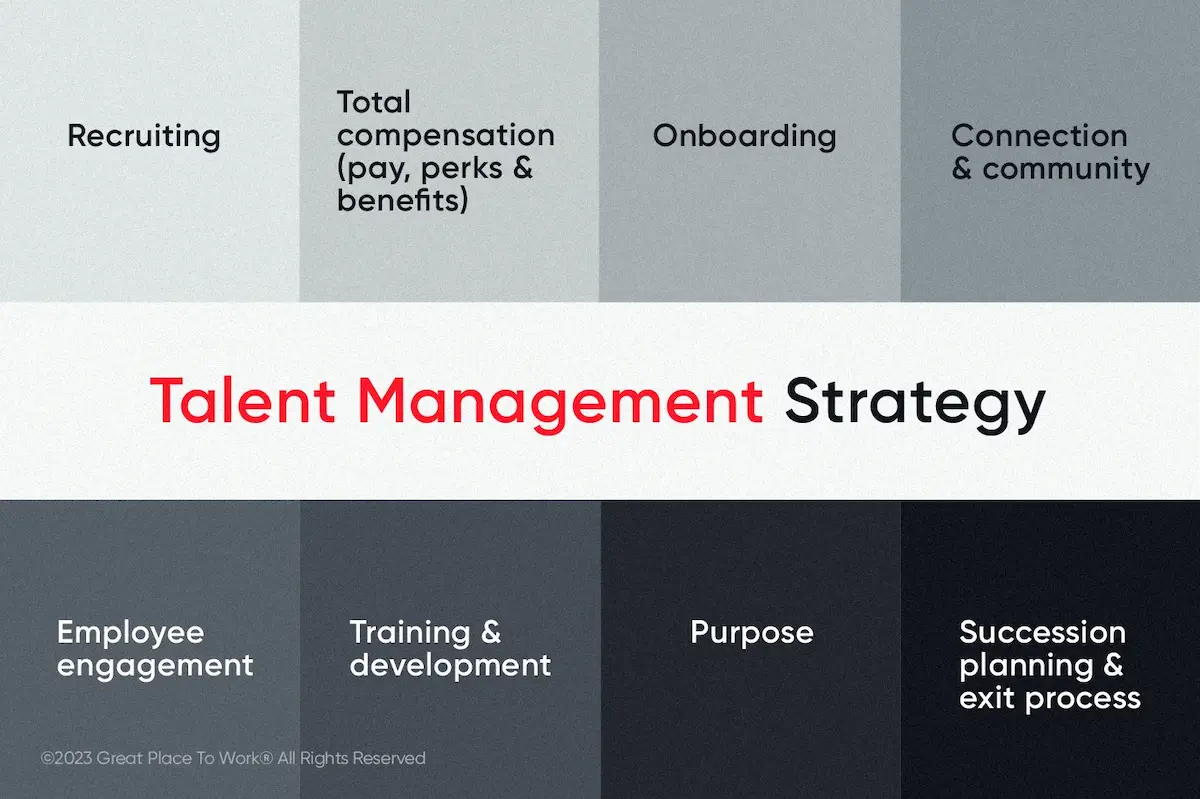
While talent management is often considered part of the broader human resources function—and in some organizations, the two may even overlap—it also stands on its own as a discipline that goes beyond traditional HR responsibilities.
According to Great Place to Work®, the human resources function tends to focus more on processes, policies, and initial hiring efforts—the starting point of talent management. However, true talent management goes further, focusing on bringing in the right people and helping them grow and thrive within the organization.
Growth can be supported in various ways, including formal development and career advancement, but also through creating a work environment where employees experience pride, purpose, and well-being. This approach to talent management is both comprehensive and future-focused.
By taking a long-term view, organizations have the opportunity to be more proactive. Rather than simply responding to current employee needs, talent management strategies can anticipate future workforce trends, helping to retain top performers and attract the talent that will drive future success.
Why is talent management important?
A well-executed talent management strategy can lead to a broader pool of applicants, stronger employee engagement, improved retention, and greater overall satisfaction. These outcomes also enhance employer branding, making the organization more attractive to current and future talent.
“Talent management is about focusing on long-term sustainability, not just addressing where employees are today.”
A study conducted in July 2022 by Great Place to Work® revealed that 55% of U.S. employees across various industries were considering leaving their jobs within six months. This trend is especially pronounced among millennial and Gen Z workers, who are increasingly seeking fairness, diversity, and a stronger sense of purpose at work.
For those overseeing talent management, this highlights the need to not only attract the right people, but also to identify gaps within the organization. Without this alignment, even newly attracted talent may choose to leave shortly after joining.
“The focus for a lot of organizations is, externally, how to attract talent,” says a senior advisor from Great Place to Work®. “But it’s important to figure out how you can maintain the best talent that you’ve got … Of course, it’s important to put your best foot forward externally, but don’t take the focus off what you could be doing internally.”
Directing efforts inward can also significantly reduce hiring expenses. According to the Society for Human Resource Management (SHRM), the average cost per hire is nearly $4,700. However, insights from E.L. Goldberg & Associates suggest that the real cost may be closer to four times the position’s annual salary.
How talent management has changed
Global events such as the COVID-19 pandemic and social justice movements have significantly influenced what employees expect from their workplaces. With multiple generations represented in today’s workforce, employers must adapt to meet evolving expectations and remain competitive in attracting and retaining talent.
Here are five key talent management trends to monitor:
- Hybrid and remote work: Many organizations have adopted hybrid or fully remote models since COVID-19. These flexible arrangements are especially valued by employees from underrepresented groups, offering greater autonomy, time savings, and location flexibility. As a result, employers are rethinking how they manage communication, engagement, benefits, and leadership strategies.
- Purpose: There has been a clear shift in individual priorities. Research from Great Place to Work® highlights that employees are seeking meaningful work and a stronger sense of purpose—factors that have become leading indicators of turnover when missing from the employee experience.
- Power shift: With more job openings than available workers in many industries, candidates now hold greater influence in negotiations. This shift in leverage has prompted organizations to reconsider how they compete for top talent.
- DEIB initiatives: Expectations around diversity, equity, inclusion, and belonging (DEIB) have grown. Organizations are being called to increase representation within leadership and implement more transparent, fair policies around promotions and growth opportunities.
- Culture of care: The pandemic prompted a re-evaluation of how employers support their teams. Today’s workforce looks for meaningful benefits such as flexible hours, generous sick leave, unlimited paid time off, and support programs like childcare stipends.
How to create a talent management program
It can be tempting to treat talent management as an extension of recruitment alone, but doing so would limit its impact. Talent management isn’t just about hiring the right people—it’s about keeping them engaged and supported throughout their time with the organization.
Here’s how to develop a talent management strategy that hits all the right notes:
- Assess your employee experience
Start by establishing a clear baseline that allows you to set goals and measure progress. This includes asking key questions such as: What is our current strategy? Where are we starting? Where do we want to go? What’s the timeline? What metrics will define success?
Conduct a thorough HR analysis to understand how employees are currently experiencing the workplace culture. Use detailed employee surveys that provide segmented results, allowing you to identify patterns and root causes of specific outcomes.
Listening to employees should go beyond standard surveys. Consider qualitative methods like open-ended questions, focus groups, or one-on-one interviews. Creating an environment of psychological safety is essential to collecting honest, valuable feedback.
- Ensure your EVP aligns with company values
Your employee value proposition (EVP)—what your organization offers employees—should reflect your core values. For instance, if your company values growth and learning, your EVP should include meaningful development opportunities like mentoring or training programs.
One example comes from Target, which demonstrated its commitment to employee development through its Dream to Be program, offering debt-free education support. This initiative supports both career growth and retention.
Tea Darden, a long-time Target employee, began her career as a cashier and is now an executive team leader. Her story illustrates how aligned values and meaningful support can foster long-term success.
“Leaders saw the potential there and helped me go through the motions… Having these different leaders really care and dig deep and say, ‘You can do this.’” - Keep reviewing and adjusting
Effective talent management is not a one-time initiative. It requires ongoing evaluation through workforce analytics to determine what is working and where adjustments are needed. Policies and programs should be continuously refined based on current findings.
“Look beyond what’s currently happening, because it’s always evolving,” says a senior advisor at Great Place to Work®. “Make your predictions and invest in those predictions because if you’re ahead of the game, you will be ahead of your competitors. Look at market conditions. Look at what people are saying and predict what they might want in the future.”
- Communicate as you change
Whenever changes are introduced, it’s important to clearly explain the rationale. Connect the updates to the broader mission of the organization and emphasize why these shifts matter to employees. Keeping the “why” front and centre helps drive understanding and buy-in.
The more effectively you link changes to long-term benefits for both employees and the organization, the stronger the support and impact will be.
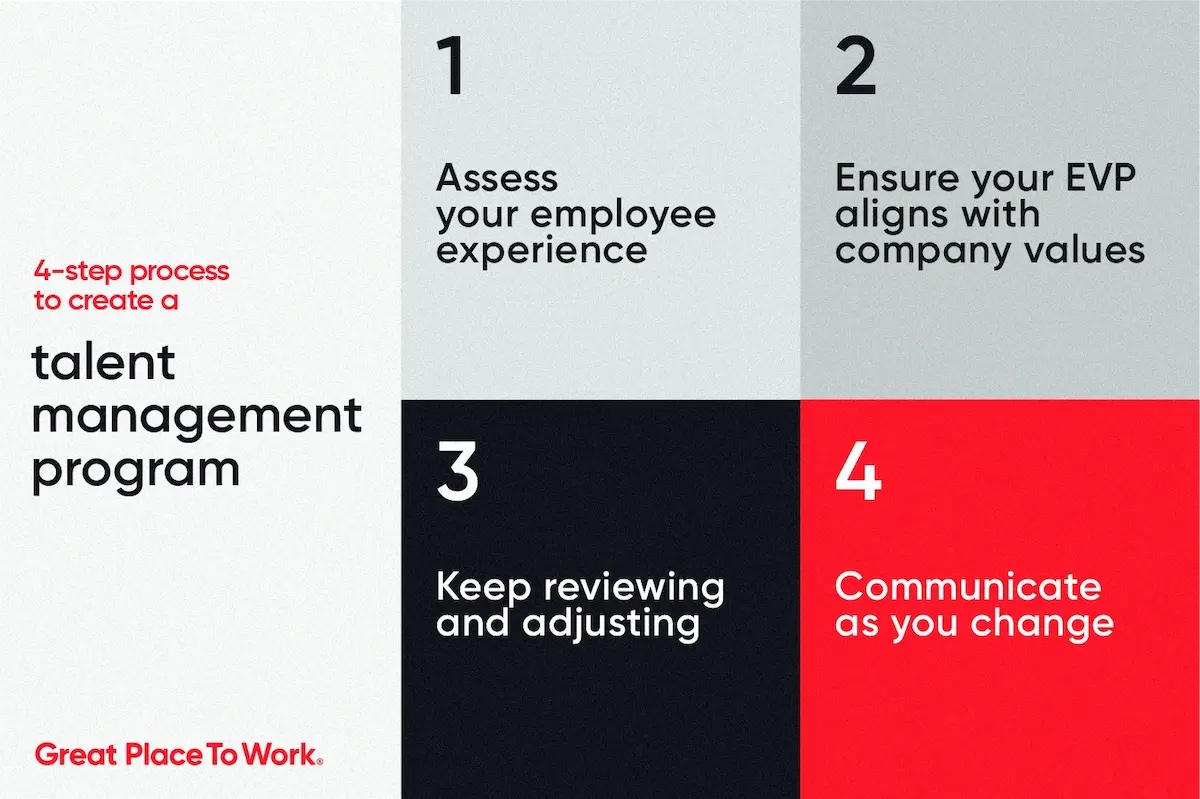
The 8 principles of talent management
A successful talent management process is guided by eight foundational principles that help organizations attract, retain, and develop the right people while fostering a strong workplace culture.
- Fairness and equity
This principle extends beyond pay to include recognition, growth opportunities, and promotions. Employees should clearly understand their standing within the organization and what it takes to advance.
“When talent thinks that things aren’t fair, find out why,” says an advisor from Great Place to Work®. “Conduct audits on compensation, make sure things are fair across gender, race, and tenure. There needs to be trust that you’re treated fairly. And if you’re not, we need to know why so we can do better.”
- Strong people managers
People managers play a vital role in translating leadership vision into daily employee experience.
“I like to think about it like a plumber,” explains a culture coach at Great Place to Work®. “Your executives are the water heater. Managers are the pipes. Even if the water is hot, broken pipes mean it won’t reach the tap.”
- Innovation by all
Employees should be empowered to contribute ideas and feel included in decision-making processes.
“Even if those ideas can’t be implemented, explaining why is still a big part of talent management,” says a senior culture coach.
- Culture and purpose
Understanding and communicating what makes your organization unique is essential. It’s what keeps employees engaged and committed over the long term.
“What keeps people at your company? What differentiates you from others in your field?”
- Openness and acceptance
A workplace must be inclusive of all identities—whether related to ability, culture, language, or background—to truly manage talent effectively.
“Often, people hesitate to join if they don’t see themselves reflected in the workplace,” says a strategic advisor. “Pretending to fit in might work short term, but it’s not sustainable.”
- Measurement
Data is key to understanding what’s working and what needs attention. Even without a formal talent program, if you have employees, you’re already managing talent.
“Start with data,” recommends a senior coach. “Don’t just fix low scores. Build on what’s already going well.”
- Personalization
Talent strategies should be tailored to individual needs and experiences. One-size-fits-all approaches often miss important nuances.
“Top-level scores are helpful, but they don’t tell the whole story,” says a customer success manager. “Focus on specific experiences within groups or teams to better understand their needs.”
- Buy-in
Talent management requires full organizational commitment. It cannot rest solely on one person or department.
“This isn’t a solo role,” says a senior advisor. “Talent leaders need resources, support, and cultural alignment from across the business.”
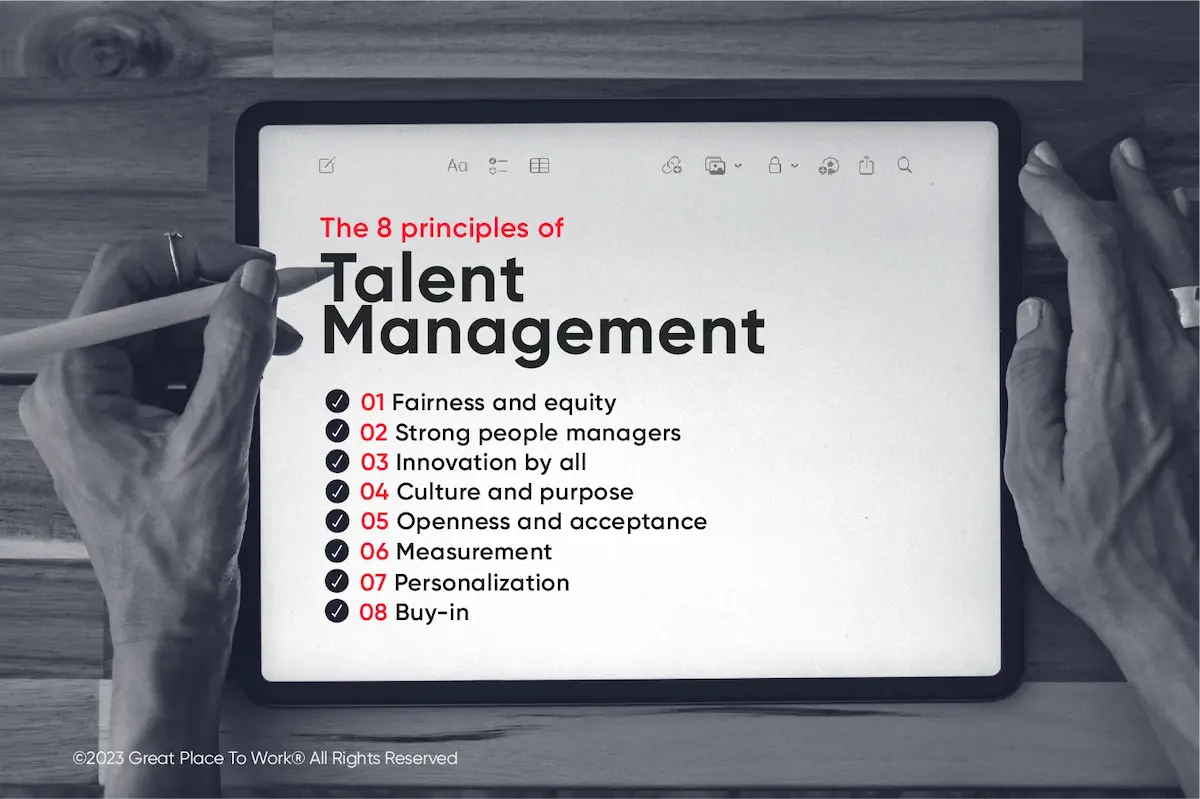
Your talent management today impacts your company’s tomorrow
Whether your organization is actively hiring or currently in a pause, the way you manage your talent has a lasting impact on business success. A strong talent management approach not only helps attract the right candidates, but also supports their long-term growth and retention.
“It’s not just strategy for how to bring them in, it’s also how to keep them happy and empower their growth,” says a senior advisor at Great Place to Work®. “Only focusing on recruitment is short-sighted. What happens after they join—their experience and treatment—matters just as much.”
Manage your talent with data and deep insights
Support your workforce through a data-informed approach with Great Place to Work Certification™. Gain valuable insights, strengthen your employee experience, and position your organization as a trusted employer through certification.

